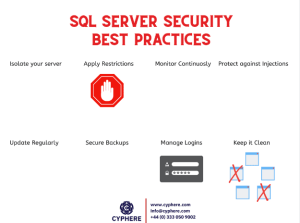
In today’s data-driven world, securing your SQL Server is more critical than ever. With cyber threats evolving rapidly, a breach in your database can lead to catastrophic consequences, including data theft, financial loss, and damage to your reputation. This comprehensive guide explores best practices and strategies to help you secure SQL Server effectively.
Why Securing SQL Server Matters
SQL Server is a powerful relational database management system (RDBMS) developed by Microsoft. It stores, retrieves, and manages large volumes of structured data for countless organizations. However, its wide adoption also makes it a prime target for attackers.
A compromised SQL Server can expose sensitive information such as customer data, credit card numbers, business strategies, and proprietary technologies. Therefore, a proactive approach to SQL Server security is not optional—it’s essential.
1. Keep SQL Server Updated
One of the most fundamental ways to secure your SQL Server is by keeping it up to date. Microsoft regularly releases patches and updates that fix known vulnerabilities.
- Enable automatic updates or establish a routine for manual patching.
- Regularly check the Microsoft SQL Server Security Update Guide for new threats.
- Include not only SQL Server itself but also the operating system and any related software in your patching strategy.
2. Use Strong Authentication and Authorization
Access control is a cornerstone of SQL Server security. Always enforce the principle of least privilege (PoLP) to ensure users and applications have only the necessary permissions.
Authentication Tips:
- Enable Windows Authentication over SQL Server Authentication whenever possible. It integrates with Active Directory and provides better security.
- If SQL Server Authentication is necessary, enforce strong password policies, including complexity, expiration, and lockout settings.
Authorization Tips:
- Create custom roles with the least privileges needed.
- Avoid using sa (system administrator) for daily tasks.
- Audit and review user roles and permissions regularly.
3. Encrypt Data in Transit and at Rest
Encryption is vital for protecting sensitive data from unauthorized access.
Encrypting Data in Transit:
- Use SSL/TLS to secure connections between SQL Server and client applications.
- Configure Force Encryption in the SQL Server Network Configuration settings.
Encrypting Data at Rest:
- Use Transparent Data Encryption (TDE) to encrypt the physical files of the database.
- Use Always Encrypted to protect sensitive columns, such as Social Security Numbers or credit card details, from unauthorized viewing.
4. Enable SQL Server Auditing
SQL Server provides built-in auditing features that track events at the database and server level. This is vital for detecting suspicious activities and maintaining compliance.
Tips for Effective Auditing:
- Enable SQL Server Audit and configure it to monitor sensitive actions, such as changes in user permissions or failed login attempts.
- Store audit logs securely and consider forwarding them to a SIEM (Security Information and Event Management) system for real-time analysis.
5. Protect SQL Server Configuration Settings
Misconfigured settings can create security vulnerabilities. Regularly review and adjust configurations using the SQL Server Surface Area Configuration tool or similar auditing scripts.
Key Configuration Guidelines:
- Disable unnecessary features and services (e.g., Database Mail, xp_cmdshell).
- Turn off SQL Server Browser unless needed.
- Set default ports to non-standard values to minimize exposure to port scans.
6. Backup and Disaster Recovery
Security isn’t just about preventing breaches—it’s also about recovery. A well-designed backup and disaster recovery plan ensures you can quickly restore your SQL Server environment if the worst happens.
Backup Tips:
- Automate full, differential, and transaction log backups.
- Store backups in encrypted and off-site locations.
- Test backup restoration procedures regularly.
7. Implement Network Security Controls
Isolate your SQL Server from public networks as much as possible. Use firewalls, Virtual LANs (VLANs), and network segmentation to limit access.
Best Practices:
- Place SQL Server behind a firewall.
- Allow access only from trusted IP addresses and applications.
- Use VPNs or IPsec tunnels for remote database access.
8. Monitor for Suspicious Activity
Continuous monitoring is essential for real-time detection of threats.
Tools and Techniques:
- Use SQL Server Profiler or Extended Events for in-depth analysis.
- Implement Data Loss Prevention (DLP) solutions.
- Leverage third-party monitoring tools for advanced threat detection and alerting.
9. Secure Physical and Cloud Infrastructure
Whether your SQL Server is on-premises or in the cloud, physical and infrastructure security are critical.
For On-Premises:
- Limit physical access to servers.
- Secure server rooms with biometric access, surveillance, and environmental controls.
For Cloud:
- Choose reputable cloud providers like Azure SQL Database with built-in security features.
- Configure virtual network service endpoints, firewall rules, and identity-based access in the cloud environment.
10. Train and Educate Your Team
Security is only as strong as its weakest link, which is often human error. Regularly train your IT staff and database administrators on security best practices.
Training Recommendations:
- Conduct regular security workshops and simulated phishing attacks.
- Keep your team updated on the latest threats and defensive techniques.
- Create a security incident response plan and test it periodically.
Conclusion
Securing SQL Server is a continuous process that requires vigilance, proper configuration, and ongoing monitoring. By implementing the best practices discussed above—such as enforcing strong authentication, encrypting data, applying regular updates, and monitoring activity—you can significantly reduce your risk of data breaches and cyberattacks.
In an era where data is one of your most valuable assets, taking a proactive and comprehensive approach to SQL Server security isn’t just a technical responsibility—it’s a business imperative.